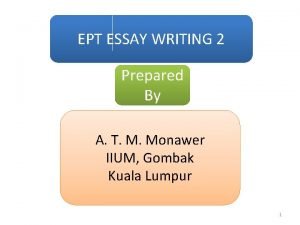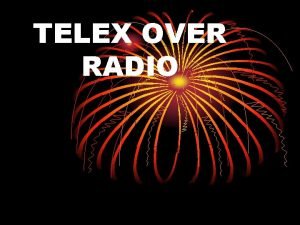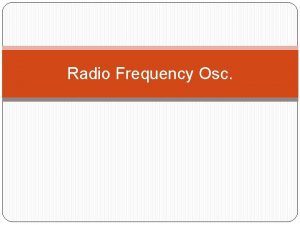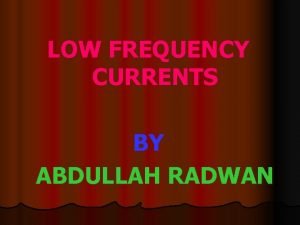Importance Of Very Low Frequency Radio Signal Data










- Slides: 10

Importance Of Very Low Frequency Radio Signal Data Registered By VLF-receiver System A. Nina, V. Čadež and V. Srećković Institute of Physics, Belgrade, Serbia Astronomical Observatory, Belgrade, Serbia

Contents • • • Ionosphere VLF signals – “ionospheric probes” Importance of creating a database for studying the ionosphere and its applications in technical and scientific research such as: -detection of different events by VLF signals -ionospheric diagnostics -study of physical and chemical processes

Introduction • Terrestrial ionosphere • Methods of investigation • Our study: low ionosphere

VLF signals – “ionospheric probes” • VLF wave propagation • Advantages: - continual emission, - large area involved for analyses, - international collaboration: AWESOME, AWESOME Abs. PAL, Abs. PAL SAVNET, SAVNET AARDDVARK • Belgrade VLF station

Significance of low ionospheric study • Science - detection of different pure natural and man-induced events - ionospheric diagnostics - study of physical and chemical processes • Telecommunications - radio communications, - planned networks of mobile communication satellites, - high precision applications of global navigation satellite systems, etc. • Explanation of application our database in scientific research and, consequently, in prediction of possible problems in the telecommunications

Importance of database • Processes in the ionosphere are: -very complex - time- and space variable • Experiment: practically impossible to exactly simulate conditions in particular cases • Theory: no real time data available for all necessary parameters needed for theoretical analyses • Statistics: requires the existence of a database that can be used to analyze the ionosphere

Detection of events • Sun: - regular variation - transient variations • Outer space • Earth: - in the atmosphere - in the lithosphere SGR 1806 -20 pure natural man-induced HESSI

Ionospheric diagnostics • The case considered: Solar flare February 18 th, 2011 • Recorded data: - GOES-15 satellite - Belgrade AWESOME receiver - DHO (Germany) transmitter (23. 4 k. Hz) • Theoretical model: Wait’s model of ionosphere • Numerical program for simulation VLF signal propagation: LWPC (Long-Wave Propagation Capability)

Physical and chemical processes (preliminary results) G(t) – electron gain rate L(t) – electron loss rate Upper half of D region: I - Quasi equilibrium regime P(t) – photo-ionization rate II - Photo-ionization regime R(t) – recombination rate I(t) – radiation flux by satellite III - Recombination regime αeff – effective recombination coefficient Ks – coefficient (dependent on energy interval of data registered by satellite)

Conclusions • Applications of low ionospheric investigations in science and information technologies • Research of low ionosphere by VLF waves • Importance of VLF radio signal data registered by receiver systems



















